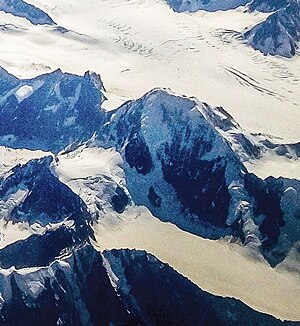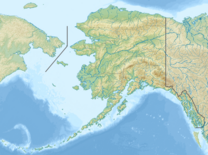Earth:Mount Lodge (Yakutat)
| Mount Lodge | |
|---|---|
| Boundary Peak 166 | |
 North aspect, from airliner | |
| Highest point | |
| Elevation | 10,548 ft (3,215 m) |
| Prominence | 2,871 ft (875 m) |
| Coordinates | [ ⚑ ] : 59°06′23″N 137°32′32″W / 59.10639°N 137.54222°W |
| Geography | |
Stikine Region, British Columbia Glacier Bay National Park and Preserve, Alaska | |
| Topo map | NTS Script error: No such module "Canada NTS". |
Mount Lodge, also named Boundary Peak 166, is a mountain in Alaska and British Columbia, located on the Canada–United States border, and part of the Fairweather Range of the Saint Elias Mountains.[1] It was named in 1908 for Senator Henry Cabot Lodge, (1850-1924), U.S. Boundary Commissioner in 1903.[2]
Climate
Based on the Köppen climate classification, Mount Lodge is located in a subpolar oceanic climate zone with long, cold, snowy winters, and cool summers.[3] Weather systems coming off the Gulf of Alaska are forced upwards by the mountains of the Fairweather Range (orographic lift), causing heavy precipitation in the form of rain and snow. Winter temperatures can drop to 10 °F with wind chill factors below 0 °F. This climate supports glaciers surrounding the mountain's slopes.
See also
- List of Boundary Peaks of the Alaska-British Columbia/Yukon border
References
- ↑ Mount Lodge, Alaska/British Columbia
- ↑ "Mount Lodge". United States Geological Survey. https://geonames.usgs.gov/apex/f?p=gnispq:3:::NO::P3_FID:1420628.
- ↑ Peel, M. C.; Finlayson, B. L.; McMahon, T. A. (2007). "Updated world map of the Köppen−Geiger climate classification". Hydrol. Earth Syst. Sci. 11 (5): 1633. doi:10.5194/hess-11-1633-2007. ISSN 1027-5606. Bibcode: 2007HESS...11.1633P.
External links
 |


